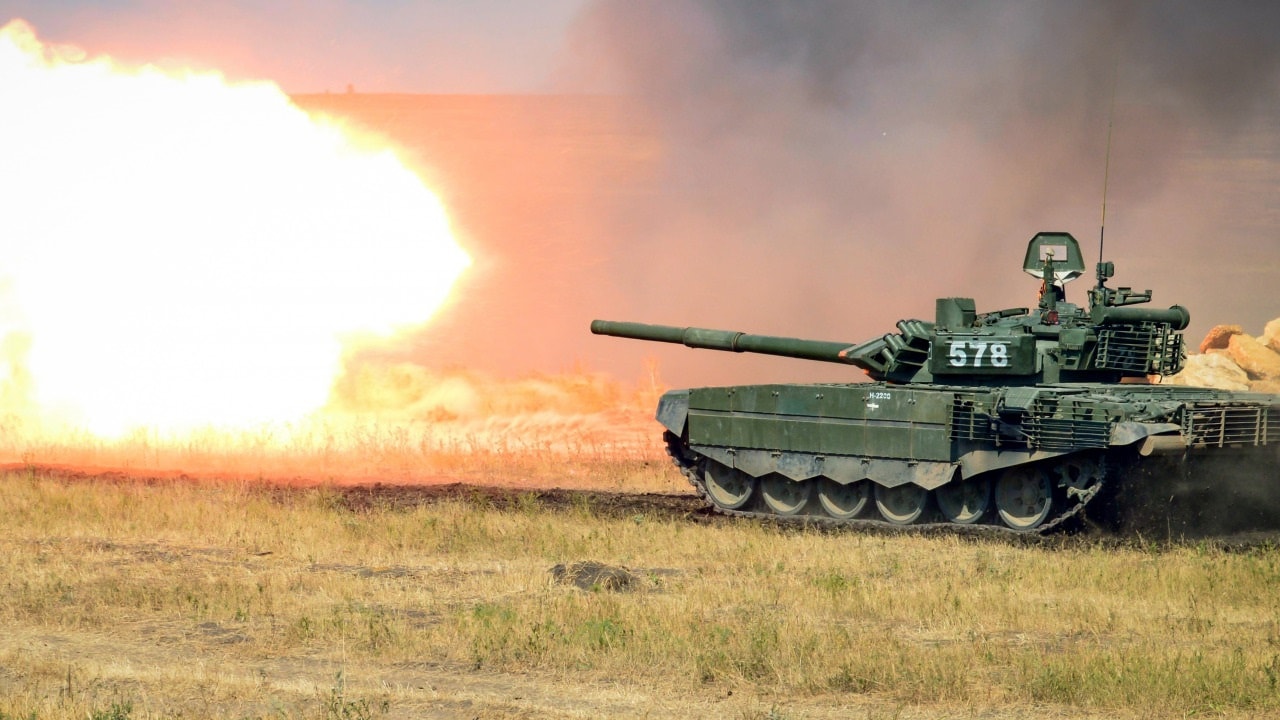Iraq, Syria, the Chechen Wars, and now Ukraine are all battlefields where the Soviet-era T-72 tank has fought, yet there have been many upgraded variants throughout the years.
Maintenance and modernization have of course been a challenge for the tank, however, newer variants employ reactive armor, laser rangefinders, and improved thermal sights.
It is well known that Soviet-era Russian tanks such as the T-72 continue to get decimated in Ukraine, in part due to top-down vulnerability and successful Ukrainian employment of anti-armor weapons and tactics.
During the Soviet era, the T-72 was heavily exported throughout the Warsaw Pact, as well as to non-aligned powers including the former Yugoslavia and India, among others. The T-72 remains in Ukraine’s current arsenal.
Old Russian T-72 Tanks Keep Rolling
Overall, more than 5,400 T-72s were built, thousands of which make up the large Russian ground armored force. GlobalFirepower.com’s most recent assessment cites that Russia currently operates as many as 12,000 tanks, a number placing Ukraine’s force at a massive deficit. Despite this, Ukrainian armor and defensive anti-armor tactics continue to prove successful against Russian T-72s and T-90s.
The key question with the T-72 is the unclear extent to which the platforms have been modernized. How many have been sustained and upgraded with new sensors, ammunition, armor configurations, and command and control technology? For instance, during famous Gulf War tank battles in the early 90s, Soviet-built Iraqi T-72s got decimated by U.S. Army Abrams tanks in large measure to the advanced thermal sights on the Abrams allowing tank crews to see and hit Iraqi tanks from distances where they themselves were not seen.
Therefore, while Russia may clearly have thousands of tanks, just how many of them have been maintained with recent innovations or even upgrades woven into the more modern variants? An interesting report published by the Federation of American Scientists (FAS) details some of the upgrades integrated into the T-72M variants.
“The advanced passive armour package of the T-72M and T-72M1 can sustain direct hits from the 105mm gun equipped M1 Abrams at up to 2,000 meter range. The later T-72Ms and T-72M1s are equipped with laser rangefinders ensuring high hit probabilities at ranges of 2,000 meters and below,” the report states.
Stacking Up Tanks
Overall, numerous assessments claim the T-72 is much more advanced than the T-64 it is replacing, and the most advanced T-72B1 variant has thick, layered protection, conventional cast armor, and an anti-radiation liner. The tank operates with a low-vibration, V-12 piston air-cooled 840hp engine, FAS writes. The T-72 even has a quasi-amphibious capability.
“Two 200-liter auxiliary fuel drums can be fitted on the rear of the hull. The T-72 can be fitted with a snorkel for deep fording, and takes about 20 minutes to prepare for amphibious use,” the FAS essay says.
As for its gun, the T-72’s 125mm smoothbore gun uses an automatic loader and can reportedly penetrate M1 Abrams armor at ranges up to 1,000 meters.
None of these attributes, however, amount to much if the tanks themselves are not maintained and modernized, as evidenced by tank wars during the Gulf War. Without upgraded thermal sights, advanced layered armor, and other modern innovations, the T-72s remain extremely vulnerable, as evidenced by events in Ukraine.
The U.S. Army Abrams, by extension, is now an entirely different platform from its inception in the 1980s by virtue of years of ongoing upgrades, so in the absence of a comparable effort, Soviet-built T-72s simply won’t be able to compete.
MORE: The F-35 Now Comes in Beast Mode
MORE: Why the U.S. Navy Tried to Sink Their Own Aircraft Carrier
Kris Osborn is the Military Affairs Editor of 19FortyFive and President of Warrior Maven – Center for Military Modernization. Osborn previously served at the Pentagon as a Highly Qualified Expert with the Office of the Assistant Secretary of the Army—Acquisition, Logistics & Technology. Osborn has also worked as an anchor and on-air military specialist at national TV networks. He has appeared as a guest military expert on Fox News, MSNBC, The Military Channel, and The History Channel. He also has a Masters Degree in Comparative Literature from Columbia University.

